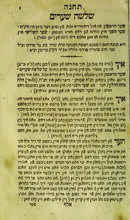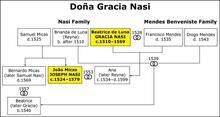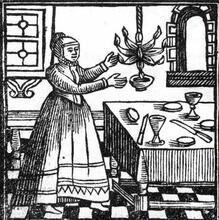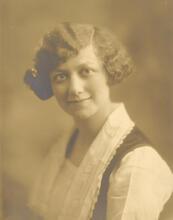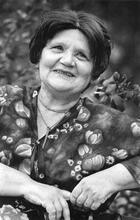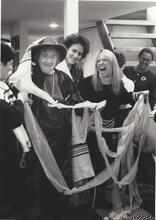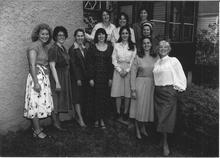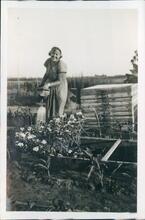Ludomir, Maid of
Hannah Rachel, the Maid of Ludmir, was committed to prayer and religion from a young age, but a series of traumatic events motivated her to begin practicing male ritual Hasidic observances. She well renowned for her miracle-granting abilities, but as her popularity grew, so did the displeasure of male Hasidic leaders, who wanted her to get married. She acquiesced and was married briefly but quickly divorced her husband, and she subsequently spent the rest of her life in Jerusalem. Although the Maid of Ludmir was able to hold a position of religious power in the Hasidic community without the help of powerful Hasidic men in her family, her story ultimately upholds gender expectations.
The Maid of Ludmir (also spelled Ludomir) was a semi-legendary figure, reputed to have been one of the few Women in Hasidism who functioned as a fully-fledged spiritual master (Zaddik or Rebbe). Most of the information about her originates in oral traditions of “old women in Volhynia,” first collected and published in 1909 by the historian Samuel Abba Horodezky (1871–1987). These were subsequently subjected to his own as well as others’ elaborations and expansions, which appeared in a variety of popular-historical, belletristic, journalistic- and memoiristic works. Significantly, the hagiographical literature of nineteenth century Hasidism makes no mention whatever of her, nor is any mystical or ethical teaching attributed to her in other genres of hasidic writing. She is, however, mentioned briefly in an 1883 satirical work by a female/sing.: Member of the Haskalah movement.maskil and, following the publication of Horodezky’s reports, in a handful of twentieth-century hagiographical anthologies.
Early Life
Hannah Rachel, the Maid, was the only daughter of Monesh Verbermacher, an educated and well-to-do Jew in the Volhynian town of Ludmir (Vladimir-Volynskiy). From an early age she was distinguished not only because of her beauty but also—unusually for a girl—by dint of her ardor in prayer and remarkable aptitude for scholarship. Her betrothal to a beloved childhood playmate, which entailed the customary separation of bride and groom until the wedding, distressed the Maid and led her to withdraw from society.
Hanna’s distress was exacerbated by the sudden death of her mother, following which she became a recluse, never leaving her room except to visit her mother’s grave. On one of her visits to the cemetery she fell into unconsciousness, which was followed by a prolonged and mysterious illness. When she recovered, she claimed to have been given “a new and elevated soul.” She broke off her engagement and declared that she would never marry, having “transcended the world of the flesh.”
Commitment to Religion and Marriage
From then on, Hanna adopted the full rigor of male ritual observance and absorbed herself, like a male pietist, in intense study and prayer. She became known as the “holy Maid” or the “Virgin” of Ludmir and acquired a reputation for miracle working. Men and women, including rabbis and scholars, flocked to the Houses of study (of Torah)bet midrash in Ludmir which functioned as her hasidic court. She would grant blessings on request and deliver her weekly hasidic teaching at the third Sabbath meal, as was customary among the male Zaddikim.
While her popular following grew, the male leadership of the movement disapproved, viewing her activities as a pathological manifestation of the powers of evil and impurity. Pressure was put on the Maid to abandon the practice of Zaddikism and to resume her rightful female role in marriage.
Following the personal intervention of Mordecai of Chernobyl (1770–1837)—the most eminent Zaddik of the region—she reluctantly agreed to marry, but the marriage was never consummated and soon ended in divorce. She married again but divorced once more, apparently remaining a “maiden” to the end of her life. However, her marriages did have the desired effect of putting an abrupt end to her career as a Rebbe. She eventually immigrated to the Holy Land, a remote corner of nineteenth-century hasidism. Here, as is almost certainly confirmed by archival documentation from the 1860s and 1870s, she spent the last years of her life in Jerusalem as a childless widow affiliated to the Volhynian hasidic kolel (a group of Ashkenazi Jews in Palestine, from one country or district, whose members received funds from their countries of origin).
Legacy
The Maid of Ludmir was exceptional among the cluster of women reputed to have exercised charismatic authority within the hasidic world of their day. Unlike most of them, she was not related by family ties—as mother, daughter, sister or widow— to any of the illustrious male Zaddikim. She could not, therefore, draw on the associative authority which some Jewish women were able to derive from their connection to distinguished male relatives; her powers were entirely her own.
Nevertheless, while her career is often celebrated as a pioneering “feminist” success, the very terms in which the Maid tradition has been preserved present her case as an instructive failure. It serves precisely to reinforce, rather than undermine, the gender boundaries she attempted to cross.
The phenomenon of a spiritually empowered holy virgin, so familiar to the wider Christian environment of hasidism, was alien to the Jewish tradition, which had always prized, albeit within limits, the practice of sexual abstinence by some men, while greeting with suspicion and ascribing no value to the adoption of celibacy by women. The anomaly of the celibate female Rebbe was therefore perceived as an aberration of nature and a social deviation which the hasidic leadership was quick to suppress. Only in the twentieth century, under the impact of modern feminism and the egalitarian elements of Zionist ideology, could the Maid of Ludmir tradition present itself as an inspirational model for national revival and proof of the alleged eradication of gender boundaries in hasidism.
Deutsch, Nathaniel. “New Archival Sources on the Maiden of Ludmir.” Jewish Social Studies 9:1 (2002): 164–172.
Deutsch, Nathaniel. The Maiden of Ludmir: A Jewish Holy Woman and Her World. Berkeley: 2003.
Horodezky, Shmuel Abba. “The Ludmir Maid” (Russian). Eveiskaya Starina 1:2 (1909): 219–222.
Horodezky, Shmuel Abba. Hasidism and the Hasidim (4 vols.) (Hebrew) (second edition, Tel Aviv: 1943), vol. 4, 67–71.
Rapoport-Albert, Ada. “On Women in Hasidism, S. A. Horodezky and the Maid of Ludmir Tradition.” In Jewish History. Essays in Honour of Chimen Abramsky, edited by Ada Rapoport-Albert and Steven J. Zipperstein. London: 1988.
This source contains additional bibliographical references in note 2, and an expanded version in Zaddik and Devotees: Historical and Sociological Aspects of Hasidism (Hebrew), edited by David Assaf. Jerusalem: 2001.
Rapoport-Albert, Ada, and Deborah Greniman. Women and the Messianic heresy of Sabbatai Zevi: 1666-1816. Littman Library of Jewish Civilization, 2011.
Winkler, Gershon. They Called Her Rebbe: The Maiden of Ludmir. New York: 1991.


